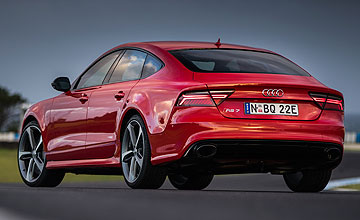BY TIM ROBSON AND TUNG NGUYEN | 14th May 2015

Audi Australia, though, is one step ahead today, inviting GoAuto along to sample the charms of its updated RS6 Avant and RS7 Sportback in the controlled environs of Phillip Island’s GP track.
The weather isn’t playing nice, but it’s definitely a quattro kind of day.
In essence, there’s very little difference between the two top-line variants.
Both are powered by Audi’s 4.0-litre direct-injection V8 that comes equipped with a pair of turbochargers nestled between the cylinder banks, and both are set up with fifth-generation Haldex all-wheel-drive underpinnings that direct 60 per cent of the car’s drive to the rear wheels.
Both will do 0-100km/h in just 3.9 seconds – a time that was impressive for a Porsche 911 Turbo just six years ago – and onto a limited top speed of 250km/h.
Both are backed by a customised eight-speed traditional automatic transmission, both are set up out of the box with a progressive air-sprung suspension arrangement, massive brakes and huge 21-inch rims with sticky Continental tyres.
Externally, of course, it’s pretty obvious what the differences are. The RS6 weighs 15kg more than the 2005kg RS7, but both sit on the same 1936mm wheelbase. The wagon is – unsurprisingly – taller at 1461mm versus 1419mm, but the RS7 is a little longer at 5012mm against the wagon’s 4979mm.
The RS6 is also slightly wider at 1936mm, against 1911mm for the Sportback.
You can also shove 565 litres of stuff into the RS6, or1680 litres with the seats folded down, while you’ll have to make do with 535 litres in the Sportback.
Interestingly, both cars can also tow a braked trailer of up to 2100kg. Try doing that with your R8!Towing the old fridge to the tip is not the main reason to get one of Audi’s exec rockets, though. With the four-mode Driver Select dial on Normal, the everyday manners of both machines are little different to those of the A6 donor car, though the ride is noticeably firmer and the steering tauter.
If you drive sedately, you’ll even see fuel economy numbers beneath 10 litres per 100 kilometres for both cars 9.5 for the RS7 and 9.6 for the RS6 wagon.
There’s also the matter of the burbling and rumbling from the exhausts on throttle overrun – no hardship, truth be told. Clever acoustic film-treated front-side and windscreen glass makes short work of wind noise though Audi claims a noise reduction of up to 8dB over normal tinted glass.
Out on the limit-free environs of the track, though, it’s all about Dynamic mode, where throttle and shift maps are sharpened, suspension firms up and things get, well, a lot noisier.
The dual-turbo motor doesn’t rev as high as, say, Audi’s RS4 4.2-litre naturally aspirated V8, but boy, does it clang into its 5700rpm in double-quick time. There’s not a hint of lag, just a wave of power and torque that demands gear shifts as quickly as you can muster them.
In fact, we find it easier just to leave the modified eight-speeder in Sport shift mode and let it figure things out. It changes down under braking with an automatic blip of throttle to smooth the change and to minimise torque disruption, and allows the pilot to pay attention to the rapidly arriving horizon.
And the noise! If there’s a concern that the aural presence of a performance car is in danger thanks to the exhaust-repressing tendencies of a turbocharger, the RS twins belay that in no uncertain manner. The procession of test cars thundering around the track all day is an ear-inspiring treat, while the rifle-crack out of the twin pipes on the off-throttle overrun is simply heavenly.
The way the cars build speed is otherworldly, especially from 100km/h, so the ceramic brakes – a $20,940 option – comes as a welcome addition.
The cost does sound ludicrous, but the Audi Driving Experience guys tell us they will not change pads or rotors once during a car’s 12-month tour of duty with them.
Both cars are equipped with Audi’s best traction and stability control systems, including torque vectoring, that’s calibrated to give the RS owner more freedoms than the equivalent system in, say, an A6.
What stands out for us, though, is the different characters of what, on paper, appear to be fundamentally identical cars.
The RS7 is fast and fit, but it lacks just a little of the precision that’s evident in the RS6, with a heavier, lazier feel through the steering wheel and a reluctance to take a set through the front end.
Similarly, the two-tonne RS6 lacks the sharper edge of its baby brother, the RS4, but it feels better at the tiller than the RS7 by a small margin.
Both cars, though, are amazingly accomplished devices on the confines of one of Australia’s fastest race tracks. Our real-world drive time was limited, but it’s easy to see the real-world practicality that the RS6 brings to the performance car equation.
While the $229,400 RS6 has no real rivals in the marketplace, the $242,000 RS7 will go toe-to-toe with BMW’s $298, 675 M6 Gran Coupe and Mercedes-Benz’s $249,900 CLS 63 AMG (all prices before on-road costs).
If we had to pick one, the RS6 stacks up as the better ‘value’ proposition. It’s more than $12,000 cheaper, it carries a lot more gear and – in our eyes, at least – looks the better of the two machines. The RS7, though, is like few other cars on the road, and presents as the cheapest of its mainline rivals.
Either way, Audi’s most powerful machines show that pure performance isn’t necessarily limited to low-slung two door sports machines.